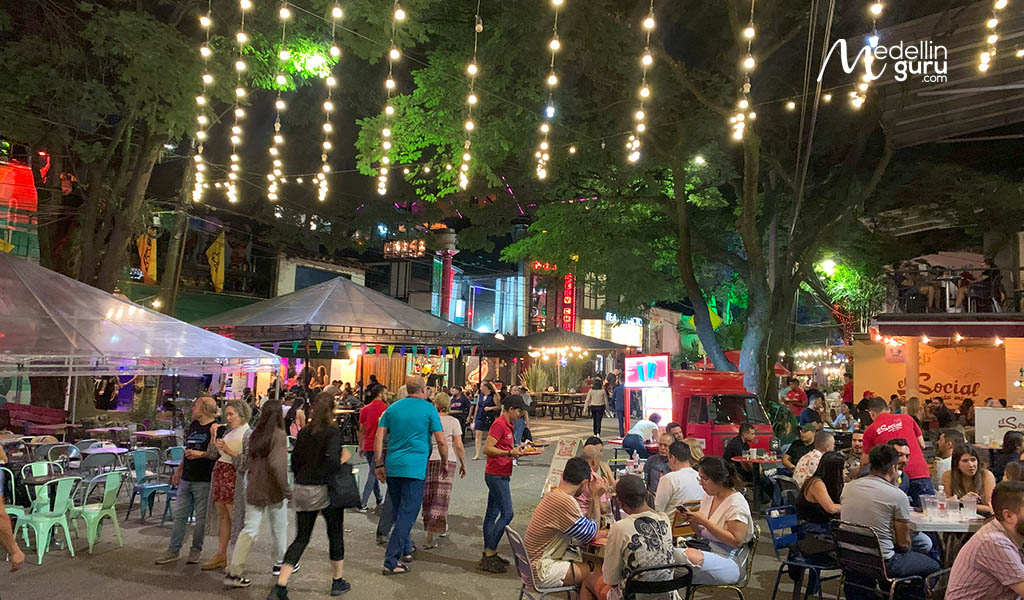Scopolamine, also known as Devil’s Breath, is a drug used in Colombia for the purpose of robbery. But there are a number of urban myths circulating about Scopolamine
For example, according to figures reported by the Valle de Aburrá Metropolitan Police, by May 2023, there are 373 cases of theft with scopolamine have been reported in the city. But there are a number of urban myths circulating about Scopolamine.
Reportedly there are about 50,000 cases of scopolamine poisoning in Colombia each year. Poisoning with this drug is sometimes a method used by robbers, although this has been exaggerated with many unfounded urban myths.
I recently met a foreigner in Medellín who was a victim of scopolamine. And he recommended that I cover this on the Medellin Guru website.
This foreigner told me he went to a bar with a girl he had just met. And he believes this girl spiked his drink. He didn’t remember anything until he woke in a motel the next day feeling as if he had big night of partying.
He felt dehydration, dizziness, nausea and head/body aches. And all his cash and his cell phone were gone. Luckily, he still had the keys to the hotel he was staying in. Also, he went to a hospital where it was confirmed that he was a victim of scopolamine.
Get Health Insurance and travel in Colombia safely
We always recommend having travel medical insurance to assist you in an emergency. This is essential since many foreigners need a good travel insurance policy to save a few bills. You can access the Medellin Guru Insurance Service by clicking the green button below.
Medellin Guru Insurance Service
The insurance agency we partnered with has helped 1.377 Medellin Guru readers
What is Scopolamine (Devil’s Breath)?
Scopolamine, also known as “devil’s breath”, burundanga and hyoscine, is a chemical substance that is made from the scopolia plant. This plant is most commonly found near Bogotá and also in the departments of Atlántico and Magdalena in Colombia.
Scopolamine (Hyoscine) was first written about in 1881 and started to be used for anesthesia around 1900. Hyoscine is produced from plants of the nightshade family. The name “scopolamine” is derived from one type of nightshade known as Scopolia while the name “hyoscine” is derived from another type known as Hyoscyamus niger.
Hyoscine has a number of legitimate medical uses including:
- Postoperative nausea and vomiting and sea sickness
- Motion sickness (often applied as a transdermal patch behind the ear)
- Gastrointestinal spasms
- Renal or biliary spasms
- Aid in gastrointestinal radiology and endoscopy
- Irritable bowel syndrome (IBS)
- Eye inflammation
Hyoscine is considered anti-spasmodic in low doses and may be used to relax smooth muscle tissue or prevent motion-sickness induced nausea. Scopolamine is even considered by some a miracle drug that helps with motion sickness and severe nausea.
It is sometime used as a premedication (especially to reduce respiratory tract secretions) before surgery.
In addition, scopolamine is known to produce a loss of memory and hallucinations following exposure to larger doses, which is similar to the effect of benzodiazepines or alcohol poisoning, which can affect the ability to resist criminal aggression.
Furthermore, scopolamine has been occasionally used recreationally for its hallucinogenic properties. But the experiences are often unpleasant, mentally and physically. It is also physically dangerous, so repeated use is very rare.
Why is Scopolamine (Devil’s Breath) Dangerous?
VICE produced a widely-viewed documentary in 2012 (seen above) that shows that the effects of scopolamine, which include extreme susceptibility and amnesia.
In higher doses it is a poison having hallucinogenic and memory-inhibiting effects. And it can render a victim unconscious for 24 hours or more. Also, in very high doses, it can cause respiratory failure and even death.
In addition, it’s tasteless and odorless. So, it’s quite easy to slip into drinks and food. And once consumed, it can cause a range of psychoses including disorientation, paranoia and hallucinations.

Urban myth – transmitted by business card.
Urban Myths About Scopolamine (Devil’s Breath)
There a few common urban myths about scopolamine:
1. Can you be drugged with a business card?
There is an urban myth circulating that a transcutaneous delivery mechanism using business cards, pamphlets or flyers laced with the drug, can be effective.
However, this is an urban myth. The quantity of toxin diffusing through the skin barrier after one short contact of the fingers with an object like a business card is considered by medical professionals to be too small of an amount to be readily absorbed in the body and unlikely to have any significant effect.
The bottom line is that skin exposure is very unlikely, as the dose that can be absorbed by the skin is too low to have any effect.
In addition, studies by The Universidad CES in Colombia, have found that the majority of the scopolamine cases, the drug was administered by someone who mixed it into their drink.
Also, if someone were to take scopolamine tablets and pulverize them into a powder and blow it into your face, medical professionals consider this not having much effect.
2. Will you turn into a zombie?
This is unlikely. There is a lack of any conclusive proof of scopolamine’s usefulness as a zombification drug. But this has not stopped people from trying to stretch its actual documented effects.
Scopolamine blocks neurotransmitters that carry information to the part of the brain that stores short-term memory. So, what actually happens to people under the effect of scopolamine is simply not recorded by the brain.
Law enforcement agencies have experimented with the use of scopolamine as a kind of “truth serum.” However, it was reportedly ineffective for getting reliable information. Also, in experiments by law enforcement it didn’t really cause people to follow suggestions or fall into a “zombie-like” state.”
3. Is “Devil’s Breath” really so common?
The U.S. State Department stated that “unofficial estimates put the annual scopolamine incidents in Colombia at approximately 50,000.” However, scopolamine has a short life span in the human body – only around 12 hours. So, this makes is difficult to collect reliable statistics.
If you use the 50,000 number, that is only about 0.1 percent of the population of Colombia at about 50 million. So, that is approximately 1 out of 1,000 people. In addition, according to ACN, about 20 percent of hospital admissions for poisoning in Bogotá are due to this drug.
But more commonly used drugs are cheaper benzodiazepine drugs like valium and Xanax. A study by ACN in Bogotá found that out of nearly 1,000 patients admitted for scopolamine poisoning, 43.7 percent had benzodiazepine drugs in their system and only 12.5 percent had scopolamine in their system.

Provenza, one of the most popular party sectors in Medellín
Medellin Guru Insurance Service
The insurance agency we partnered with has helped 1.377 Medellin Guru readers
Avoiding Scopolamine (Devil’s Breath) Incidents
The U.S. Embassy recommends that American citizens adhere to the following recommendations to minimize the likelihood of being victimized by scopolamine while in Colombia:
- Avoid going into bars or nightclubs alone (although groups have also been targeted)
- Never leave drinks or food unattended
- Do not accept food or drinks from strangers
- Do not leave bars, restaurants or nightclubs with strangers
And I would add to this list, be careful about inviting strangers to your home and seek medical assistance if you think you have been drugged.
The majority of these incidents tend to occur in night clubs and bars, and normally the victims are men, perceived to be wealthy, which are often targeted by young, attractive women.
According to an ACN study in Bucaramanga, 70 percent of victims of scopolamine poisoning were males between the age of 30 and 45 and in 94 percent of cases, the motive was robbery.
In addition, we have additional security tips in our article about security in Medellín and safety tips for expats.

Hospital Pablo Tobón Uribe, the best hospital in Medellín, photo by Hospital Pablo Tobón Uribe
Medellin Guru Guides
Download Safety Guide for US Citizens in Colombia we have created with helpful information about Medellín and Colombia.
What to do if a Victim of Scopolamine (Devil’s Breath)
If you are a victim, you should get medical help and see a doctor. And if the symptoms are severe, go to a hospital. Also, here is a list of the 24 best hospitals in Colombia. Nine of these best hospitals are in Medellín and nine are in Bogotá.
In addition, if you are a U.S. citizen, you should contact the U.S. embassy in Bogotá to report the incident. The embassy is staffed 24×7 and can contact the local Colombian authorities on your behalf to encourage the authorities to fully investigate.
Furthermore, to get a report needed for insurance claims and obtaining new documents, the best place to do this is at a Unidades de Reacción Inmediata office. In Medellín, this office is located at Calle 72 # 64 E-139, which is open 24 hours.
There is also a Facebook group called Colombia Scopolamine Victims & Alerts created a few months ago that aims to share information about the criminals doing this. So, others can avoid going out on dates with them and avoid being the next victim.
Medellín Scopolamine Statistics
According to an article in 2022 in El Colombiano (In spanish) , 2022 there is a reduction in the reports of these cases compared to the same period in 2021. However, according to statistics, in Medellín, there was one case of scopolamine at day.
A few years ago, reports showed; theft per day during a period of three years from 2016 to 2018, 602 people were affected by thefts in Medellín at the hands of criminals who drugged their victims. And 208 of these cases were in 2018. Note that not all of these cases were scopolamine, as other drugs such as benzodiazepine and phenothiazine are also used.
According to the Fiscalía investigation of a number of these cases, bars, taverns and nightclubs are the places where contacts are most established between the perpetrator and his victim, with 228 cases in the last two years. This is followed by taxis (45); social networks like Facebook, Tinder, Badoo and Colombian Cupid (17); and the house of the victim (14).
The places where thefts using drugs are concentrated, according to the Police and Prosecutor’s Office, are locations that are characterized by the presence of bars, clubs and restaurants, with a large number of visitors and foreigner tourists. The majority of the drugging cases were in the following locations in Medellín:
- La Candelaria (El Centro): Parque del Periodista, Plaza de Botero, Parque de San Antonio, Barrio El Chagualo, University of Antioquia (Along Calle 67-Barranquilla), Calle 33 with Av. Oriental (barrio San Diego), barrio San Benito and Calle 58 with Carrera 47.
- El Poblado: Parque Lleras and Provenza.
- Laureles: LA 70 (Carrera 70 between the Metro station Estadio and U.P.B.)
- Itagüí: Barrio San Fernando, sector La Raya, Central Mayorista.
Keep in mind that many cases of drugging may not be reported. So, the count is likely much higher.
Furthermore, there is a Colombia Scopolamine Victims & Alerts group on Facebook. This group is intended to help share and spread information about scopolamine incidents in Colombia. Victims commonly share their experiences in this group.
Medellin Guru’s Safety and Security Series
Safety is the biggest concern of foreigners visiting Colombia or planning to move to Colombia. So, we have a series of 15 popular articles about safety and security in Colombia:
- Is Colombia Safe? Colombia Security and Safety Tips
- Is Medellín Safe? Medellín Security and Safety Tips
- What are the Safest Neighborhoods in Medellín and the Aburrá Valley
- Medellín Robbery: Expat Experience Being Robbed at Knifepoint
- Colombia Gun Laws: Is it Legal to Have a Gun in Colombia?
- Scopolamine: The Realities of Devil’s Breath in Colombia
- Colombia Protests: Tips for Foreigners to Stay Safe During Protests
- Is Bogotá Safe? Bogotá Security and Safety Tips
- Is Cartagena Safe? Cartagena Security and Safety Tips
- Is Cali Safe? Cali, Colombia Security and Safety Tips
- Is Santa Marta Safe? Santa Marta Security and Safety Tips
- Is Pereira Safe? Pereira, Colombia Security and Safety Tips
- Is Manizales Safe? Manizales Security and Safety Tips
- Is Bucaramanga Safe? Bucaramanga Security and Safety Tips
- Is Barranquilla Safe? Barranquilla Security and Safety Tips
The Bottom Line: Scopolamine (Devil’s Breath)
The bottom line is that there are some urban myths circulating about scopolamine and it’s been sensationalized. But the use of drugs like scopolamine to incapacitate and rob victims in Colombia can and does happen.
In over eight years living in Medellín, I have only met one expat who was a victim of scopolamine poisoning. However, I have heard it’s more common in Bogotá.
Also, most of the scopolamine incidents happen to people at night at bars and nightclubs. So, take care and don’t leave drinks or food unattended or accept drinks or food from strangers.
Do you believe you or someone you know has been affected by scopolamine?
Medellin Guru Social media
Be part of our community. Find out about news, participate in events and enjoy the best of the city.




